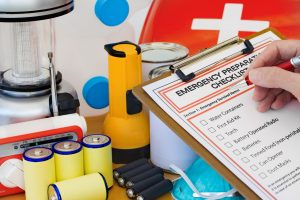Fires, hurricanes, floods, zombie apocalypse or a visit from the in-laws are all reasons you may need to head for the hills in a hurry. When you do need to evacuate your home, having a ready-packed ‘bug-out bag‘ that you can grab on the run will make your life so much easier and can even mean the  difference between life and death. The bug out bag is a good start to emergency preparedness.
difference between life and death. The bug out bag is a good start to emergency preparedness.
Each emergency kit will be tailored to the needs of your family and your pets so you may not need everything on this list or perhaps you can think of a few things we left off. Leave out those things which aren’t essential because a bug-out bag should (if anything) be portable and easy to carry.
Choose the backpack itself carefully so that it’s comfortable to carry comfortably. You may need two bags to separate out the camping gear if you’re headed for a local shelter.
- Passports, vaccine charts and other essential documents and copies of your insurance and driver’s licences
- Vaccine records for pets which may be necessary when crossing borders
- 3 litres of clean water
- Water canteen or bottle
- Water filter and water purification tablets
- A written list of important phone numbers to emergency services and family members in case your phone doesn’t work
- Alternative way to communicate like a CB radio or long-distance walkie talkie. See the Midland 75 822
- Spare charger for your phone with solar phone charger
- Emergency radio
- Protein bars and dehydrated meals
- Small gas stove and fuel
- Cooking pot with pot scourer
- Spork
- Camping mug
- Fleece jacket
- Rain poncho
- Spare underwear and socks
- Hiking boots
- Hat
- Tarp and tent
- Sleeping bag and blanket (a sleeping pad or cot can be added)
- Matches or a lighter
- Survival blanket
- First aid kit (plus any medication you or your pets take)
- Bug spray
- Wet towlettes
- Hand sanitizer
- Camping soap
- Travel towel
- Toothbrush and toothpaste
- Deodorant
- Feminine hygiene products
- Survival knife
- Camping saw
- LED headlamp or flashlight
- Batteries
- Candles
- Duct tape
- Cash
- Can opener (a multi-tool can take care of your knife and can opener needs with some extra features)
- Paracord
The bug-out bag is a good start to emergency preparedness, but it’s not the only thing you need to do.
- Map out clear routes to get out of the house from every room. Practice these with your family.
- Ensure that your family knows the difference between a fire alarm and a CO2 alarm and what to do when these go off.
- Everyone in the home should know where the fire extinguishers are and how to use them
- Have a designated meeting point in the event of a disaster that all members of your family know how to reach from school, their work places and other places they frequent.
- Know where your local medical facilities are and ensure your children know too.
- Know where your local shelters are. It’s important to note that many shelters don’t allow animals, so find alternatives that allow you to bring your pets like pet-friendly motels in the area.
- Know how to use everything in your bug-out bag. Learn to make fires and pitch a tent. Know how to administer emergency medications and basic first aid.
Being prepared for an emergency may save lives and can help you cope with a disaster better. In extreme circumstances, help may be days away and being resourceful can help tide you over until emergency services arrive.
Need some good karma? ‘Like’ us on Facebook and get more good vibes than you can shake a sharp stick at!





Pingback: The Quintessential Bug Out Bag List for Any Emergency | Going Green Space
Pingback: A Proper Emergency Bug-Out Bag Could Save Your Life – Today's News
I am really inspired along with your writing skills as smartly as with the layout on your blog. Is that this a paid subject matter or did you customize it your self? Anyway keep up the excellent quality writing, it’s uncommon to see a great weblog like this one today!